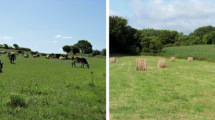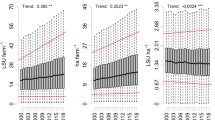Abstract
Farmers increasingly need to adjust their management practices to accommodate unexpected events such as drought, and preserve the sustainability of their production. This flexibility requires background knowledge about where and when freedom of choice can be exercised. Here, we designed an analysis framework for grassland-based farming systems in mountainous and less-favored areas. An expert-based discrimination tree characterizes organizational flexibility by determining the range of possible types of grassland use under various topographic and farming constraints such as suitability for mechanization, and ease of access to a field. A set of time windows evaluates the timing flexibility in grassland use, each associated with a combination of a grassland community type and a type of grassland use. Our results show that the outputs of the discrimination tree match for 139 of 165 grassland fields, by comparison with field data obtained in the French Aubrac region. For a particular type of grassland use, the set of time windows proves that timing flexibility in grassland use between grassland community types can increase by 15 days over a 37-day time range. When applying the two components of the analysis framework to a farm case, it shows that 24% of the farm area offers organizational flexibility, with several possibilities for grassland use. Timing flexibility for bringing forward or delaying the use of the grassland fields is unused in the farm. Most of the dates of grassland first use are similar irrespective of the diversity of grassland communities. The application of the analysis framework offers a sound evaluation of the potential flexibility to establish where and when it is possible to adjust management practices to cope with unexpected events. It can also be helpful in setting up coherent alternatives to the observed management strategies that can then be expanded in dynamic simulation models enabling deeper analysis.
Similar content being viewed by others
References
Al Haj Khaled R., Duru M., Theau J.P., Plantureux S., Cruz P. (2005) Variation of leaf traits through seasons and N-availability levels and its consequences for ranking grassland species, J. Veg. Sci. 16, 391–398.
Al Haj Khaled R., Duru M., Decruyenaere V., Jouany C., Cruz P. (2006) Using leaf traits to rank native grasses according to their nutritive value, Rangeland Ecol. Manag. 59, 648–654.
Andrieu N., Josien E., Duru M. (2007) Relationships between diversity of grassland vegetation, field characteristics and land use management practices assessed at the farm level, Agr. Ecosyst. Environ. 120, 359–369.
Bakker E.S., Ritchie M.E., Olff H., Milchunas D.G., Knops J.M.H. (2006) Herbivore impact on grassland plant diversity depends on habitat productivity and herbivore size, Ecol. Lett. 9, 780–788.
Brunschwig G., Josien E., Bernhard C. (2006) Contraintes géographiques et modes d’utilisation des parcelles en élevage bovin laitier et allaitant, Fourrages 185, 83–95.
Caballero R. (2007) High Nature Value (HNV) Grazing Systems in Europe: A Link between Biodiversity and Farm Economics, Open Agr. J. 1, 11–17.
Carsjens G.J., van der Knaap W. (2002) Strategic land-use allocation: dealing with spatial relationships and fragmentation of agriculture, Landscape Urban Plan. 58, 171–179.
Cros M.J., Duru M., Garcia F., Martin-Clouaire R. (2003) A biophysical dairy farm model to evaluate rotational grazing management strategies, Agronomie 23, 105–122.
Da Pontes L.D., Soussana J.F., Louault F., Andueza D., Carrere P. (2007) Leaf traits affect the above-ground productivity and quality of pasture grasses, Funct. Ecol. 21, 844–853.
Dale A.J., Mayne C.S., Laidlaw A.S., Ferris C.P. (2008) Effect of altering the grazing interval on growth and utilization of grass herbage and performance of dairy cows under rotational grazing, Grass Forage Sci. 63, 257–269.
Darnhofer I., Schneeberger W., Freyer B. (2005) Converting or not converting to organic farming in Austria: Farmer types and their rationale, Agr. Human Values 22, 39–52.
Dedieu B., Chia E., Leclerc B., Moulin C.H., Tichit M. (2008) (Eds.), L’élevage en mouvement. Flexibilité et adaptation des exploitations d’herbivores, Quae, Versailles.
Diaz S., Cabido M. (2001) Vive la difference: plant functional diversity matters to ecosystem processes, Trends Ecol. Evol. 16, 646–655.
Dogliotti S., Rossing W.A.H., van Ittersum M.K. (2003) ROTAT, a tool for systematically generating crop rotations, Eur. J. Agron. 19, 239–250.
Duru M., Tallowin J., Cruz P. (2005) Functional diversity in low-input grassland farming systems: characterisation, effect and management, Agron. Res. 3, 125–138.
Duru M., Al Haj Khaled R., Ducourtieux C., Theau J.P., de Quadros F.L.F., Cruz P., Do plant functional types based on leaf dry matter content allow characterizing native grass species and grasslands for herbage growth pattern? Plant Ecol., in press, doi:10.1007/s11258-008-9516-9.
Duru M., Cruz P., Magda D. (2008) La conduite des couverts prairiaux, source de flexibilité, in: Dedieu B., Chia E., Leclerc B., Moulin C.H., Tichit M. (Eds.), L’élevage en mouvement. Flexibilité et adaptation des exploitations d’herbivores, Quae, pp. 57–72.
Garcia F., Guerrin F., Martin-Clouaire R., Rellier J.P. (2005) The human side of agricultural production management — the missing focus in simulation approaches, in: Proceedings of the MODSIM 2005 Conference, Melbourne, Australia, pp. 203–209.
Garnier E., Laurent G., Bellmann A., Debain S., Berthelier P., Ducout B., Roumet C., Navas M.L. (2001) Consistency of species ranking based on functional leaf traits, New Phytol. 152, 69–83.
Grime J.P. (1998) Benefits of plant diversity to ecosystems: immediate, filter and founder effects, J. Ecol. 86, 902–910.
Groot J.C.J., Rossing W.A.H., Jellema A., Stobbelaar D.J., Renting H., van Ittersum M.K. (2007) Exploring multi-scale trade-offs between nature conservation, agricultural profits and landscape quality — A methodology to support discussions on land-use perspectives, Agr. Ecosyst. Environ. 120, 58–69.
Huston M.A. (1994) (Eds.) Biological diversity. The coexistence of species on changing landscapes, Cambridge Univ. Press.
Ingrand S., Bardey H., Brossier J., Dedieu B., Degrange B., Lémery B., Pasdermadjian P. (2007) Flexibility of suckler cattle farms in the face of uncertainty within the beef industry: a proposed definition and an illustration, J. Agr. Educ. Ext. 13, 39–48.
Kemp D.R., Michalk D.L. (2007) Towards sustainable grassland and livestock management, J. Agr. Sci. London 145, 543–564.
Lavorel S., Garnier E. (2002) Predicting changes in community composition and ecosystem functioning from plant traits: revisiting the Holy Grail, Funct. Ecol. 16, 545–556.
Le Ber F., Benoit M. (1998) Modelling the spatial organization of land use in a farming territory. Example of a village in the Plateau Lorrain, Agronomie 18, 103–115.
Martin G., Duru M., Martin-Clouaire R., Rellier J.P., Theau J.P., Therond O., Hossard L. (2008) Towards a simulation-based study of grassland and animal management in livestock farming systems, in: Proceedings of the iEMSs Fourth Biennial Meeting, Barcelona, Catalonia, pp. 783–791.
Maurer K., Weyand A., Fischer M., Stöcklin J. (2006) Old cultural traditions, in addition to land use and topography, are shaping plant diversity of grasslands in the Alps, Biol. Conserv. 130, 438–446.
McCown R.L., Hammer G.L., Hargreaves J.N.G., Holzworth D.P., Freebairn D.M. (1996) APSIM: a novel software system for model development, model testing and simulation in agricultural systems research, Agr. Syst. 50, 255–271.
Parsons A.J. (1988) The effect of season and management on the grass growth of grass sward, in: Jones M.B., Lazenby A. (Eds.), The grass crop, Chapmann and Hall, London, pp. 129–178.
Steinfeld H., Gerber P., Wassenaar T., Castel V., Rosales M., Haan C. (2006) Livestock’s long shadow: environmental issues and options, FAO, Rome.
Thenail C., Baudry J. (2004) Variation of farm spatial land use pattern according to the structure of the hedgerow network (bocage) landscape: a case study in northeast Brittany, Agr. Ecosyst. Environ. 101, 53–72.
Tichit M., Doyen L., Lemel J.Y., Renault O., Durant D. (2007) A coviability model of grazing and bird community management in farmland, Ecol. Model. 206, 277–293.
Author information
Authors and Affiliations
Corresponding author
About this article
Cite this article
Martin, G., Hossard, L., Theau, J.P. et al. Characterizing potential flexibility in grassland use. Application to the French Aubrac area. Agron. Sustain. Dev. 29, 381–389 (2009). https://doi.org/10.1051/agro:2008063
Accepted:
Issue Date:
DOI: https://doi.org/10.1051/agro:2008063




